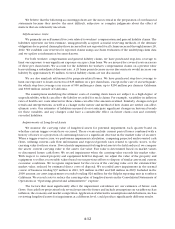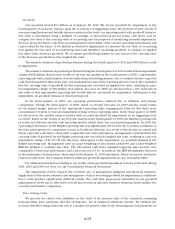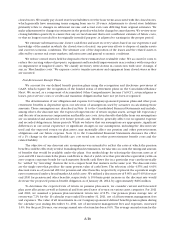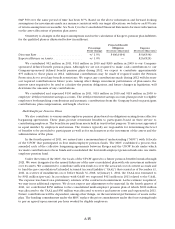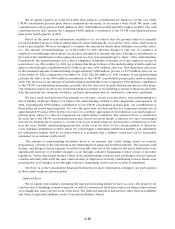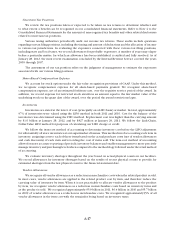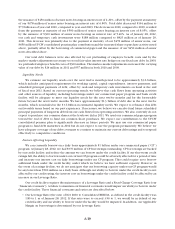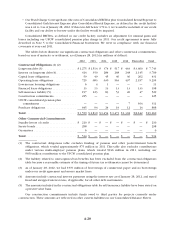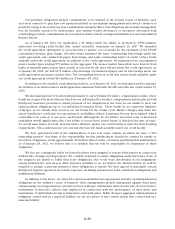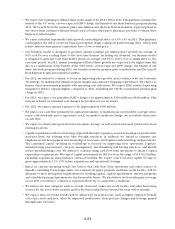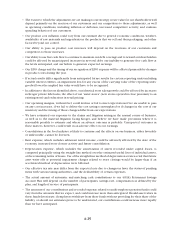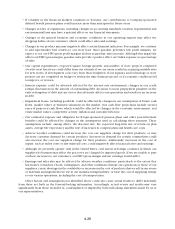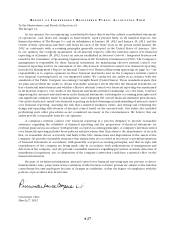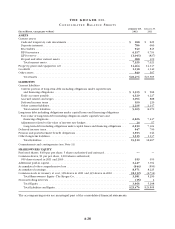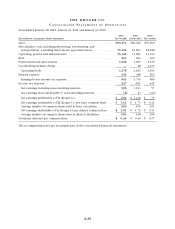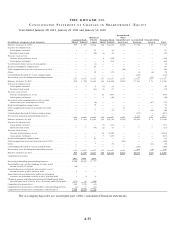Kroger 2011 Annual Report Download - page 77
Download and view the complete annual report
Please find page 77 of the 2011 Kroger annual report below. You can navigate through the pages in the report by either clicking on the pages listed below, or by using the keyword search tool below to find specific information within the annual report.A-22
RE C E N T L Y IS S U E D AC C O U N T I N G ST A N D A R D S
In September 2011, the FASB amended its standards related to the testing of goodwill for impairment.
The objective of this amendment is to simplify the annual goodwill impairment evaluation process. The
amendment provides entities the option to first assess qualitative factors to determine whether it is more
likely than not that the fair value of a reporting unit is less than its carrying value as a basis for determining
whether it is necessary to perform the two-step goodwill impairment test. The two-step impairment test is
now only required if an entity determines through this qualitative analysis that it is more likely than not that
the fair value of the reporting unit is less than its carrying value. The new rules are effective for interim and
annual periods beginning after December 15, 2011; however, entities were permitted to adopt the standards
early. We did not adopt these standards early for our 2011 goodwill impairment testing process. Because the
measurement of a potential impairment loss has not changed, the amended standards will not have an effect
on our Consolidated Financial Statements.
In June 2011, the FASB amended its rules regarding the presentation of comprehensive income. The
objective of this amendment is to improve the comparability, consistency and transparency of financial
reporting and to increase the prominence of items reported in other comprehensive income. Specifically,
this amendment requires that all non-owner changes in shareholders’ equity be presented either in a single
continuous statement of comprehensive income or in two separate but consecutive statements. The new
rules were to become effective for interim and annual periods beginning after December 15, 2011. In
December 2011, the FASB deferred certain aspects of this standard beyond the December 15, 2011 effective
date, specifically the provisions dealing with reclassification adjustments. Because the standards only affect
the display of comprehensive income and do not affect what is included in comprehensive income, the
standards will not have a material effect on our Consolidated Financial Statements.
In May 2011, the FASB amended its standards related to fair value measurements and disclosures. The
objective of the amendment is to improve the comparability of fair value measurements presented and
disclosed in financial statements prepared in accordance with GAAP and International Financial Reporting
Standards. This amendment primarily changed the wording used to describe many of the requirements in
GAAP for measuring fair value and for disclosing information about fair value measurements. In addition, the
amendment clarified the FASB’s intent about the application of existing fair value measurement requirements.
The new standard also requires additional disclosures related to fair value measurements categorized within
Level 3 of the fair value hierarchy and requires disclosure of the categorization in the hierarchy for items that
are not recorded at fair value but as to which fair value is required to be disclosed. The new rules became
effective for interim and annual periods beginning after December 15, 2011. While we are still finalizing our
evaluation of the effect of this amended standard on our Consolidated Financial Statements, we believe this
new standard will not have a material effect on our Consolidated Financial Statements.
OU T L O O K
This discussion and analysis contains certain forward-looking statements about Kroger’s future
performance. These statements are based on management’s assumptions and beliefs in light of the information
currently available. Such statements relate to, among other things: projected changes in net earnings
attributable to The Kroger Co.; identical supermarket sales growth; expected product cost; expected pension
plan contributions; our ability to generate operating cash flows; projected capital expenditures; square footage
growth; opportunities to reduce costs; cash flow requirements; and our operating plan for the future; and are
indicated by words such as “comfortable,” “committed,” “will,” “expect,” “goal,” “should,” “intend,” “target,”
“believe,” “anticipate,” “plan,” and similar words or phrases. These forward-looking statements are subject to
uncertainties and other factors that could cause actual results to differ materially.
Statements elsewhere in this report and below regarding our expectations, projections, beliefs, intentions
or strategies are forward-looking statements within the meaning of Section 21E of the Securities Exchange
Act of 1934. While we believe that the statements are accurate, uncertainties about the general economy, our
labor relations, our ability to execute our plans on a timely basis and other uncertainties described below
could cause actual results to differ materially.


